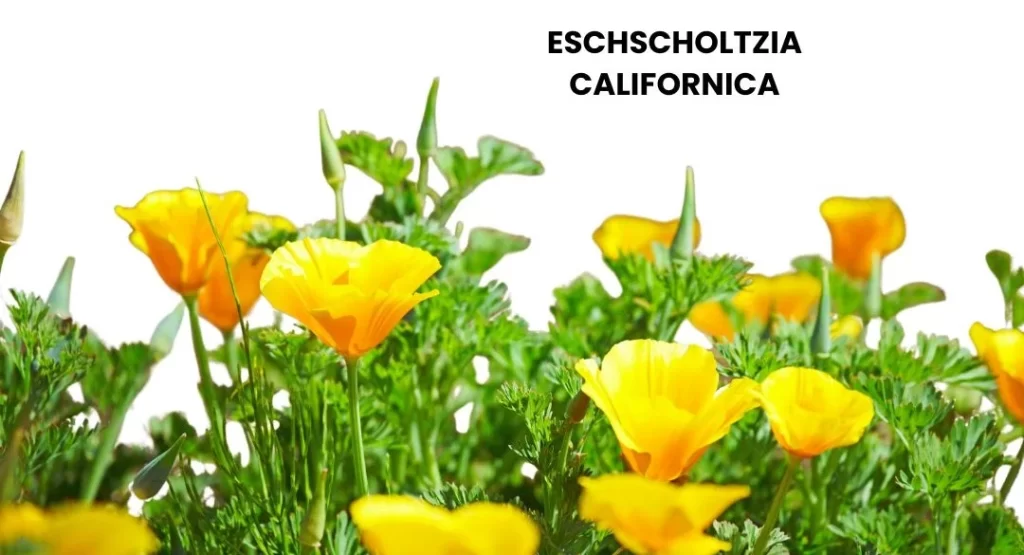Eschscholtzia californica, commonly known as California Poppy, is a plant known for its sedative and analgesic properties.
Despite containing alkaloids similar to those in morphine, it is considered a non-addictive and milder alternative.

Table of Contents
ToggleSOURCE INFORMATION
Scientific Classification
- Kingdom: Plantae
- Clade: Angiosperms
- Clade: Eudicots
- Order: Ranunculales
- Family: Papaveraceae
- Genus: Eschscholzia
- Species: E. californica
Origin and Historical Facts
- Native Region: California Poppy is native to the western United States and Mexico, especially California.
- Historical Use: Native Americans have used California Poppy for its sedative properties.
- It was traditionally used to treat insomnia, anxiety, and various aches and pains.
- Botanical Description: It is a perennial plant that grows to about 5-60 cm tall with vibrant orange, yellow, or red flowers.
- The plant prefers well-drained soil and full sun exposure.
DRUG PATHOGENESIS
- Experiments: Animal studies have demonstrated that Eschscholtzia californica has a stronger effect than morphine.
- It induces general weakness, torpor (a state of physical or mental inactivity), accelerated respiration, and complete paralysis of the limbs. It also slows circulation.
- Mode of Action: The plant contains alkaloids, including protopine and cryptopine, which contribute to its sedative and analgesic effects.
KEY CHARACTERISTICS
- Sedative Effects: Used as a soporific remedy, aiding in sleep without the risk of addiction.
- Analgesic Properties: Effective for relieving mild to moderate pain.
- Non-Addictive: Unlike opiates, California Poppy does not lead to dependence or withdrawal symptoms.
DETAILED ORGAN SYMPTOMS
MIND
- General Weakness: A sense of overall debilitation.
- Torpor: Mental and physical sluggishness, lack of energy.
- Sedation: Induces sleep, helping with insomnia and anxiety.
RESPIRATORY
- Accelerated Respiration: Increased breathing rate noted in animal studies.
CIRCULATORY
- Slowed Circulation: Decreased heart rate and circulation, contributing to a calming effect.
EXTREMITIES
- Paralysis: Complete paralysis of the limbs observed in high doses during animal testing, indicating strong central nervous system effects.
MODALITIES
- Worse: No specific worsening conditions noted.
- Better: Noted for its calming and sleep-inducing effects, particularly useful in conditions of anxiety and insomnia.
WHAT ARE MODALITIES IN HOMOEOPATHY?
RELATIONSHIP WITH OTHER DRUGS
Comparisons
- Morphine: California Poppy acts similarly to morphine but is less potent and non-addictive.
- Other Sedatives: Compared with other herbal sedatives like Valerian and Passionflower, California Poppy is effective but safer due to its non-addictive nature.
DOSE
- Tincture: The tincture form is recommended for use due to its ease of dosing and efficacy.
Frequently Asked Questions (FAQs)
Is California Poppy addictive?
- No, unlike opiates such as morphine, California Poppy is non-addictive and does not cause withdrawal symptoms.
Can California Poppy be used for children?
- Yes, it is considered safe for children, especially for its mild sedative effects.
What is the recommended dosage?
- The typical dosage is in tincture form, taken as needed for anxiety, insomnia, or mild pain.
- Always follow specific dosing recommendations from a healthcare provider.
Are there any side effects?
- In general, California Poppy is well-tolerated. High doses can cause excessive sedation and muscle weakness.
Glossary of difficult words
- Soporific: Inducing sleep.
- Torpor: A state of physical or mental inactivity.
- Sedative: A substance that induces sedation by reducing irritability or excitement.
- Analgesic: A drug that relieves pain.
- Non-Addictive: Does not cause physical or psychological dependence.
California Poppy, with its non-addictive and sedative properties, serves as a valuable remedy in homeopathy and herbal medicine for treating anxiety, insomnia, and mild pain.
Its safety profile makes it suitable for a wide range of patients, including children.
